Text
Navigating Powder Days: Tips for Skiing Deep Snow
Powder days are a skier’s dream come true. The feeling of gliding through deep, untouched snow is exhilarating and can make for unforgettable memories on the slopes. However, skiing in deep snow requires a different set of skills and techniques compared to groomed runs. In this blog, we’ll guide you through essential tips and tricks to help you navigate powder days like a pro. So grab your skis,…
View On WordPress
0 notes
Text
From Bunny Slopes to Double Black Diamonds: Progressing Your Skiing Skills
Skiing is an exhilarating sport that offers a unique blend of adrenaline and tranquility as you glide down snowy mountains, surrounded by breathtaking landscapes. Whether you’re a beginner or an intermediate skier, the desire to progress and challenge yourself is natural. In this blog, we will explore how you can take your skiing skills from bunny slopes to double black diamonds, unlocking new…

View On WordPress
0 notes
Text
From Bunny Slopes to Double Black Diamonds: Progressing Your Skiing Skills
Skiing is an exhilarating sport that offers a unique blend of adrenaline and tranquility as you glide down snowy mountains, surrounded by breathtaking landscapes. Whether you're a beginner or an intermediate skier, the desire to progress and challenge yourself is natural. In this blog, we will explore how you can take your skiing skills from bunny slopes to double black diamonds, unlocking new levels of thrill and achievement along the way.
Mastering the Basics: Before diving into the world of advanced skiing, it's crucial to build a solid foundation of basic skills. Start with beginner slopes, also known as bunny slopes, and focus on learning proper stance, balance, and how to make controlled turns. Take lessons from a certified instructor who can guide you through the fundamentals, including stopping, starting, and getting up after a fall.
Expanding Your Skill Set: Once you've gained confidence on the bunny slopes, it's time to expand your skill set. Progress to intermediate slopes that offer slightly steeper terrain and more challenging conditions. Here are some essential techniques to focus on:a) Carving: Carving turns is a technique where you use the edges of your skis to make precise and controlled turns. It allows you to maintain speed and stability while tackling varied terrain.b) Parallel Skiing: Master the art of parallel skiing, where both skis remain parallel to each other throughout the turn. This technique enhances your balance and control while making turns, making it easier to handle more challenging slopes.c) Pole Planting: Incorporate pole planting into your skiing. Proper pole planting helps with timing and rhythm, aiding in maintaining balance and setting up for turns effectively.
Building Confidence on Steep Terrain: As your skills progress, you'll naturally be drawn to more challenging slopes. Here's how to build confidence on steep terrain:a) Moguls: Moguls are large, irregular-shaped mounds that form on the slopes. Practice skiing over moguls, focusing on absorbing the impact with your legs, maintaining balance, and making quick, efficient turns.b) Powder Snow: Take advantage of fresh powder snow, as it offers a forgiving surface. Practice skiing through powder, adjusting your technique to handle the softer and deeper snow conditions.c) Steep Runs: Gradually introduce yourself to steeper runs, initially selecting ones with a moderate pitch. Focus on maintaining good posture, keeping your weight centered, and using short turns to control your speed.
Tackling Advanced Terrain: Now that you've built a strong foundation and gained confidence on steeper slopes, you're ready to tackle advanced terrain, including double black diamond runs. Consider these strategies:a) Speed Control: Master advanced speed control techniques such as hockey stops, short turns, and skidding to navigate challenging terrain safely.b) Bumps and Glades: Challenge yourself on mogul runs and gladed areas. Practice navigating through tight spaces, maintaining balance, and adapting to changing terrain.c) Steeps and Chutes: Embrace the thrill of steep chutes and narrow couloirs. Ensure you have the necessary skills, focus, and confidence to handle these intense descents safely.

0 notes
Text
How to Choose the Right Skis for Your Skill Level and Terrain
When it comes to skiing, having the right equipment can make all the difference in your performance and enjoyment on the slopes. Choosing the right skis is essential, as they need to match both your skill level and the type of terrain you'll be skiing on. In this comprehensive guide, we'll take you through the factors to consider and provide valuable insights to help you select the perfect skis for your abilities and preferred terrain.
Determine Your Skill Level: Before delving into the details of ski selection, it's crucial to assess your skiing abilities honestly. Skill levels generally fall into three categories:
a. Beginner: If you're new to skiing or have limited experience, look for skis that offer stability, forgiveness, and ease of turning. Opt for softer flex skis with a narrower waist, as they are more maneuverable and provide better control.
b. Intermediate: If you can comfortably link turns and ski on varied terrain, you're an intermediate skier. Consider skis that strike a balance between stability and maneuverability. Look for medium flex skis with a slightly wider waist for improved stability on varying snow conditions.
c. Advanced/Expert: Advanced skiers who can confidently tackle challenging terrain and enjoy high speeds should opt for stiffer flex skis with wider waists. These skis provide enhanced stability, responsiveness, and superior performance on groomed runs, moguls, or powder.
Identify Your Preferred Terrain: Understanding the type of terrain you'll be skiing on is crucial when selecting skis. Different skis are designed for specific conditions and terrains, including:
a. All-Mountain Skis: If you enjoy exploring various terrain types, including groomed runs, moguls, and off-piste adventures, all-mountain skis are your best bet. These versatile skis offer a good balance of stability, maneuverability, and performance on different snow conditions.
b. Powder Skis: If you frequently find yourself seeking the deep snow and off-piste areas, powder skis are designed to keep you afloat. They feature wider waists, increased rocker, and a more pronounced tip to effortlessly glide through powder and provide excellent floatation.
c. Carving Skis: Carving skis are ideal for those who love the sensation of laying down precise turns on groomed runs. These skis have a narrow waist, a stiff flex, and deep sidecuts that allow for quick edge-to-edge transitions and maximum carving performance.
d. Freestyle Skis: If you're into jumps, tricks, and skiing in the terrain park, freestyle skis are designed for you. These skis are typically twin-tipped, allowing you to ski both forwards and backwards, with a symmetrical flex and a durable construction to withstand park features.
Consider Ski Length: Ski length plays a vital role in determining how the skis will perform for your specific skill level and terrain. While personal preferences can influence the choice, the following guidelines can help:
a. Shorter Skis: Shorter skis are generally easier to maneuver, making them suitable for beginners or those who prioritize quick turns and agility. They are also beneficial in moguls and tight spaces.
b. Longer Skis: Longer skis offer better stability, enhanced performance at high speeds, and improved floatation in powder. Advanced skiers often prefer longer skis for their increased edge grip and versatility on varied terrain.
Flex and Stiffness: The flex and stiffness of skis determine their responsiveness and stability. Softer flex skis are forgiving, easier to control, and recommended for beginners and intermediates. Stiffer flex skis provide better stability, power transfer, and edge grip, making them suitable for advanced and expert skiers who seek high-speed performance and aggressive turns.
Consider Ski Width: The width of skis, often referred to as waist width, impacts their performance on different snow conditions. Narrower waist skis (75-85mm) are more responsive and excel on groomed runs, providing quick edge-to-edge transitions and carving ability. Wider waist skis (90mm or more) offer improved floatation in powder and stability in variable conditions. For all-mountain skiing, a waist width between 85-95mm is a popular choice as it provides a good balance between versatility and performance.
Research and Read Reviews: Before making a final decision, take the time to research different ski models and read reviews from reliable sources. Pay attention to feedback from skiers with similar skill levels and preferences as yours. Their experiences can offer valuable insights and help you narrow down your options.
Demo Skis: Whenever possible, try to demo skis before making a purchase. Many ski resorts and specialty ski shops offer demo programs where you can test various models. This hands-on experience will allow you to feel how different skis perform on the slopes and give you a better understanding of what works best for your skill level and terrain.
Seek Professional Advice: If you're unsure about which skis to choose, don't hesitate to seek advice from ski experts or knowledgeable professionals at ski shops. They can provide personalized recommendations based on your specific needs and help you find the perfect skis that align with your skill level, terrain preferences, and budget.
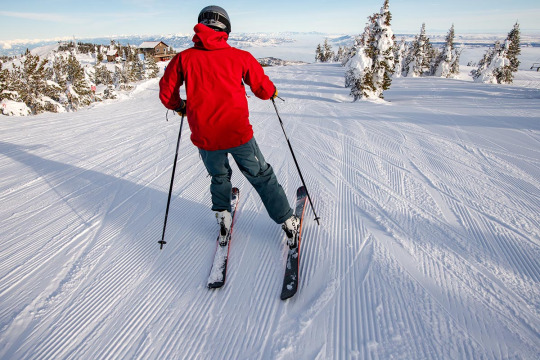
0 notes
Text
How to Choose the Right Skis for Your Skill Level and Terrain
When it comes to skiing, having the right equipment can make all the difference in your performance and enjoyment on the slopes. Choosing the right skis is essential, as they need to match both your skill level and the type of terrain you’ll be skiing on. In this comprehensive guide, we’ll take you through the factors to consider and provide valuable insights to help you select the perfect skis…

View On WordPress
0 notes
Text
Mastering the Art of Carving: Tips and Techniques for Advanced Skiers
Carving is an essential skill for any advanced skier looking to take their technique and performance to the next level. It involves making precise turns while maintaining control and balance, allowing skiers to glide effortlessly down the slopes with speed and grace. In this blog, we will delve into the art of carving and explore valuable tips and techniques that will help you become a master…
View On WordPress
0 notes
Text
Mastering the Art of Carving: Tips and Techniques for Advanced Skiers
Carving is an essential skill for any advanced skier looking to take their technique and performance to the next level. It involves making precise turns while maintaining control and balance, allowing skiers to glide effortlessly down the slopes with speed and grace. In this blog, we will delve into the art of carving and explore valuable tips and techniques that will help you become a master carver on the mountain.
Equipment and Gear: Before diving into carving techniques, it's important to ensure you have the right equipment. Here are a few key considerations:
a. Skis: Opt for skis that are specifically designed for carving. Look for narrower waists, stiffer flex, and a shorter turn radius, as these characteristics facilitate better edge grip and responsiveness.
b. Bindings: Ensure your bindings are properly adjusted to your weight, height, and skiing ability. This will optimize your control and minimize the risk of injury.
c. Boots: Invest in well-fitting ski boots that provide excellent ankle support and transmit precise movements to the skis.
Body Position and Balance: Maintaining the correct body position and balance is crucial for successful carving. Here are some pointers to keep in mind:
a. Alignment: Keep your upper body aligned with your lower body and face your shoulders downhill. Avoid leaning back or sitting too far into the turn.
b. Flexion and Extension: Flex and extend your legs smoothly during the turns. This helps absorb terrain irregularities and allows for better edge control.
c. Pressure Distribution: Concentrate pressure on the downhill ski while maintaining a light touch on the uphill ski. This maximizes edge grip and enhances stability.
Edging and Carving Techniques: To achieve clean and efficient carving turns, focus on the following techniques:
a. Edging: Initiate your turn by rolling your ankles and tilting your skis on edge. Gradually increase the edge angle as you progress through the turn, maintaining consistent pressure and control.
b. Angulation: Create angulation by inclining your entire body towards the center of the turn while keeping your hips and shoulders aligned with the slope. This helps maintain a solid edge grip.
c. Pressure Control: Manipulate the pressure on your skis throughout the turn. Start with more pressure on the downhill ski and gradually transfer it to the uphill ski as you exit the turn.
d. Early and Late Edging: Experiment with the timing of your edge engagement. Early edging involves initiating the turn by engaging the edges early, while late edging delays edge engagement until later in the turn. Practice both techniques to expand your carving repertoire.
Progressive Edging Exercises: To improve your carving skills, incorporate the following exercises into your training routine:
a. Short Turns: Practice making quick, tight turns by linking a series of short-radius arcs. This exercise helps refine your edge control and agility.
b. Long Arcs: Focus on executing long, smooth turns with consistent edge pressure and gradual edge angle progression. This exercise enhances your balance, rhythm, and overall carving proficiency.
c. Steeps and Bumps: Challenge yourself on steeper terrain and through mogul fields. This will test your ability to maintain control while carving on challenging slopes and variable conditions.
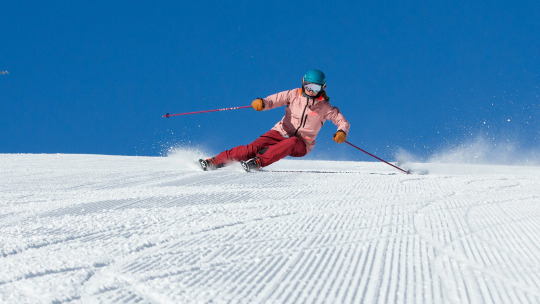
0 notes
Text
Skiing 101: A Beginner's Guide to Getting Started on the Slopes
Are you ready to embrace the exhilarating world of skiing? Whether you've always dreamed of gliding down snow-covered slopes or you're simply looking for a thrilling winter sport, skiing is a fantastic choice. This beginner's guide will equip you with the essential knowledge to hit the slopes confidently and enjoy every moment. From choosing the right equipment to mastering basic techniques, let's dive into the world of skiing!
Gear Up for Success: Before you hit the slopes, it's crucial to have the right equipment. Here's a breakdown of what you'll need:
a. Skis: Choose skis based on your height, weight, and skill level. Shorter skis are more maneuverable, making them ideal for beginners. b. Ski Boots: Ensure your boots fit snugly, providing support and control. Professional assistance at a ski shop can help you find the perfect fit. c. Poles: Poles aid in balance and maneuvering. Select poles that reach your armpits when standing upright. d. Clothing: Layer up with moisture-wicking base layers, a warm mid-layer, and a waterproof outer shell. Don't forget gloves, a hat, goggles or sunglasses, and thermal socks.
Take Ski Lessons: Investing in ski lessons is essential for beginners. Certified ski instructors will teach you proper techniques, help build your confidence, and ensure your safety on the slopes. They will introduce you to the basics, such as balancing, stopping, and turning. Start with group lessons to meet fellow beginners and share the learning experience.
Master the Basics: Skiing is all about balance and control. Here are a few fundamental techniques to practice:
a. Snowplow: The snowplow is the most basic braking technique. Point your ski tips inward, forming a "V" shape, and apply gentle pressure to the inside edges to slow down or stop. b. Turning: Initiate turns by shifting your weight and pointing your knees and hips in the desired direction. Practice making wide, sweeping turns as you gain confidence. c. Poles: Proper pole usage helps with balance and timing. Plant the pole in the snow as you initiate a turn and swing your opposite arm forward for balance.
Safety First: Skiing can be a thrilling adventure, but safety should always be a top priority. Keep these tips in mind:
a. Helmet: Always wear a helmet to protect your head from potential impacts. b. Follow Rules and Signs: Observe posted signs, ski within your ability level, and respect the rules of the resort. c. Ski with a Buddy: Skiing with a partner is not only more enjoyable, but it also ensures someone is there in case of an emergency.
Know Your Limits: As a beginner, it's important to know your limits and progress at your own pace. Don't push yourself too hard or attempt slopes beyond your skill level. Gradually challenge yourself as you gain more experience and confidence.
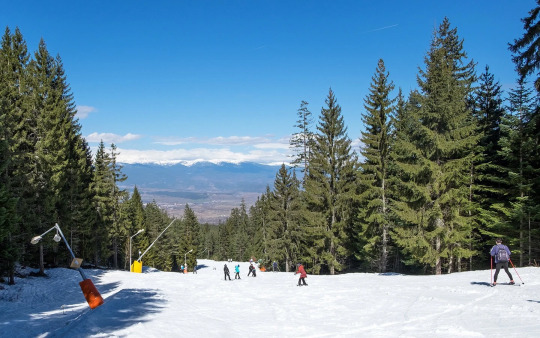
1 note
·
View note
Text
Skiing 101: A Beginner's Guide to Getting Started on the Slopes
Are you ready to embrace the exhilarating world of skiing? Whether you’ve always dreamed of gliding down snow-covered slopes or you’re simply looking for a thrilling winter sport, skiing is a fantastic choice. This beginner’s guide will equip you with the essential knowledge to hit the slopes confidently and enjoy every moment. From choosing the right equipment to mastering basic techniques,…
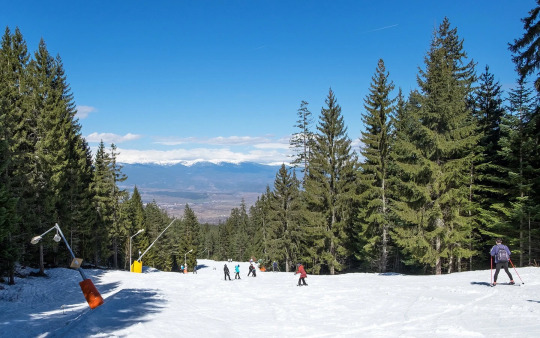
View On WordPress
1 note
·
View note
Text
The Mindset of a Skier: How to Overcome Fear and Improve Your Performance
Skiing is an exhilarating sport that combines the thrill of speed with the beauty of the snowy mountains. However, for many skiers, fear can be a significant obstacle to achieving their full potential on the slopes. In this blog post, we will delve into the mindset of a skier and explore effective strategies to overcome fear and enhance your performance on the slopes. Whether you are a beginner…
View On WordPress
1 note
·
View note
Text
The Mindset of a Skier: How to Overcome Fear and Improve Your Performance
Skiing is an exhilarating sport that combines the thrill of speed with the beauty of the snowy mountains. However, for many skiers, fear can be a significant obstacle to achieving their full potential on the slopes. In this blog post, we will delve into the mindset of a skier and explore effective strategies to overcome fear and enhance your performance on the slopes. Whether you are a beginner or an experienced skier, understanding and cultivating the right mindset can make a world of difference in your skiing journey.
Acknowledge and Understand Your Fear: Fear is a natural human response, and it's crucial to acknowledge and understand the reasons behind your fear of skiing. It could be fear of speed, losing control, or even fear of injury. By identifying the specific triggers, you can begin to address them head-on.
Set Realistic Goals: Setting realistic goals is an essential step in overcoming fear and improving your skiing performance. Break down your objectives into smaller, achievable targets that progressively challenge you. Celebrate your accomplishments along the way, as this will boost your confidence and motivate you to keep pushing your limits.
Cultivate a Positive Mindset: A positive mindset is a key ingredient for success in any endeavor, including skiing. Replace negative thoughts and self-doubt with positive affirmations. Visualize yourself skiing with confidence and grace, overcoming obstacles effortlessly. Surround yourself with supportive and like-minded individuals who can uplift and encourage you.
Focus on Technique and Skill Development: Developing strong skiing skills and technique is crucial in building confidence and overcoming fear. Take lessons from certified instructors to improve your technique and learn proper form. Practice regularly and challenge yourself gradually to enhance your skills. As you become more proficient, your fear will gradually subside.
Embrace the Learning Process: Skiing is a lifelong learning journey, and embracing the process is vital. Understand that setbacks and falls are part of the learning experience. Instead of getting discouraged, view them as opportunities to grow and improve. Learn from your mistakes, adapt your approach, and persist in your efforts. Each fall brings you closer to mastery.
Manage Your Focus and Control: While skiing, it's important to manage your focus and control. Dwelling on your fears and anxieties will only hinder your progress. Instead, focus on the present moment and the immediate task at hand. Concentrate on your technique, the feeling of the snow beneath your skis, and the beauty of the surroundings. By shifting your focus away from fear, you'll be able to ski with more fluidity and confidence.
Gradual Exposure to Challenging Terrain: As your skills improve, gradually expose yourself to more challenging terrain. Pushing your comfort zone incrementally will help you overcome fear and build resilience. Start with gentle slopes and progressively move on to steeper terrain. Each successful descent will bolster your confidence, making you more comfortable in tackling difficult runs.
Practice Mindfulness and Relaxation Techniques: Practicing mindfulness and relaxation techniques can help calm your mind and alleviate anxiety on the slopes. Deep breathing exercises, meditation, and visualization can all contribute to a sense of calmness and focus. Incorporate these practices into your pre-ski routine to help center yourself before hitting the slopes.
Celebrate Your Progress: Remember to acknowledge and celebrate your progress along the way. Recognize the milestones you've achieved, whether it's conquering a challenging slope or mastering a new technique. Reward yourself for your hard work and perseverance. Celebrating your accomplishments will reinforce positive associations with skiing and motivate you to continue improving.
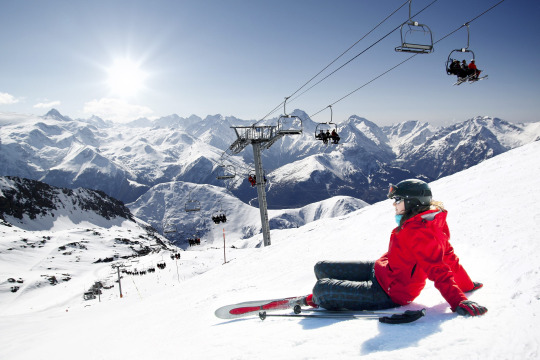
1 note
·
View note
Text
Skiing with Kids: Tips and Tricks for a Fun and Safe Family Vacation
Planning a family ski vacation can be an exhilarating experience. Skiing is a fantastic way to bond with your children, create lasting memories, and enjoy the beauty of the winter season. However, skiing with kids requires careful planning and consideration to ensure everyone’s safety and maximize the fun. In this blog post, we’ll share valuable tips and tricks to make your skiing adventure with…

View On WordPress
0 notes
Text
Skiing with Kids: Tips and Tricks for a Fun and Safe Family Vacation
Planning a family ski vacation can be an exhilarating experience. Skiing is a fantastic way to bond with your children, create lasting memories, and enjoy the beauty of the winter season. However, skiing with kids requires careful planning and consideration to ensure everyone's safety and maximize the fun. In this blog post, we'll share valuable tips and tricks to make your skiing adventure with kids an unforgettable experience.
Choose the Right Resort: Selecting a family-friendly ski resort is crucial for an enjoyable vacation. Look for resorts that offer a wide range of beginner slopes, ski lessons for children, and kid-friendly amenities such as daycare centers, tubing parks, and ice skating rinks. Additionally, check if the resort provides equipment rentals specifically designed for kids, including appropriately sized skis, boots, and helmets.
Book Ski Lessons: Enrolling your children in ski lessons is essential, especially if they're beginners. Professional instructors will teach them the basics, improve their technique, and instill confidence on the slopes. Group lessons are a great way for kids to socialize and learn alongside peers of similar skill levels. Private lessons are also available for personalized attention and faster progress.
Prioritize Safety: Safety should be your top priority when skiing with kids. Ensure that your children wear properly fitted helmets and appropriate ski gear. Teach them basic skiing etiquette, such as staying in control, yielding to other skiers, and using designated trails. Always supervise your children, especially on more challenging slopes, and establish meeting points in case you get separated.
Pack the Essentials: Don't forget to pack the essentials for a successful skiing trip with kids. Besides the obvious ski gear, remember to bring extra layers of clothing, including waterproof jackets and pants, gloves or mittens, and warm socks. Sunscreen with a high SPF is essential to protect delicate skin from harmful UV rays, and lip balm with SPF will prevent chapping. Pack snacks and water to keep your little ones energized and hydrated throughout the day.
Take Breaks: Skiing can be physically demanding, particularly for children. Take regular breaks to rest, warm up, and refuel. Many ski resorts have cozy lodges or mountain restaurants where you can take a break, grab a hot drink, and enjoy a snack. Encourage your kids to listen to their bodies and take breaks whenever they feel tired or cold.
Plan Non-Skiing Activities: While skiing is the main attraction, it's a good idea to plan non-skiing activities as well. Many resorts offer additional winter activities such as snowshoeing, sledding, ice skating, or even indoor swimming pools. These activities provide a nice break from skiing and allow the whole family to participate, regardless of skiing ability.
Capture the Memories: Family ski trips are filled with precious moments and memories. Bring a camera or smartphone to capture those joyful experiences on and off the slopes. Encourage your children to keep a ski journal or scrapbook to document their adventures, including photos, drawings, and memorable moments. These mementos will serve as cherished keepsakes for years to come.
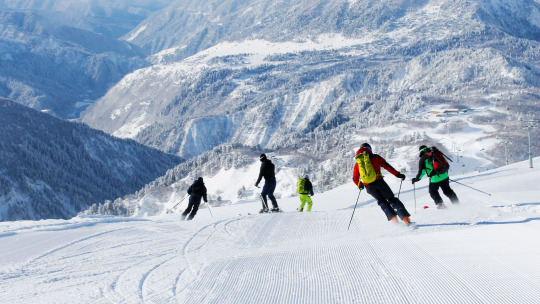
0 notes
Text
Après Ski: How to Make the Most of Your Ski Trip Off the Slopes
Skiing is undoubtedly exhilarating, but it's not just about conquering the slopes. A ski trip offers more than just a chance to glide down powdery mountainsides—it also presents an opportunity to indulge in the vibrant culture of après ski. Après ski refers to the social activities, entertainment, and relaxation that take place after a day of skiing. In this blog, we will explore some of the best ways to make the most of your ski trip off the slopes, ensuring an unforgettable experience.
Unwind at the Mountain Spa: After an adrenaline-fueled day on the slopes, there's no better way to relax than by visiting a mountain spa. Many ski resorts boast luxurious wellness facilities where you can pamper yourself with massages, hot tubs, saunas, and steam rooms. Take the time to rejuvenate your body and soothe your muscles while enjoying stunning alpine views.
Explore the Local Culinary Delights: One of the highlights of any ski trip is indulging in the local cuisine. Discover charming mountain restaurants, quaint chalets, and cozy eateries offering traditional dishes. Treat yourself to hearty comfort foods like fondue, raclette, or steaming bowls of local soup. Don't forget to pair your meal with a fine glass of wine or local craft beer for a complete après ski experience.
Après Ski Parties and Nightlife: Ski resorts are renowned for their vibrant après ski parties and lively nightlife scenes. Head to popular bars, clubs, or lounges where you can dance to live music, enjoy DJ sets, or participate in themed parties. Embrace the convivial atmosphere, mingle with fellow skiers, and create memories that will last a lifetime.
Try Alternative Snow Activities: While skiing or snowboarding might be your primary focus, there are plenty of alternative snow activities to explore. Go snowshoeing through picturesque winter trails, hop on a dog sledding adventure, or experience the thrill of snowmobiling. These activities provide a different perspective of the snow-covered landscape and allow you to appreciate the winter wonderland beyond the slopes.
Discover Local Culture and Sightseeing: Take a break from skiing and immerse yourself in the local culture and sightseeing opportunities around the ski resort. Visit historical landmarks, explore charming villages, or wander through art galleries and museums. Engaging with the local community will deepen your appreciation for the destination and add a cultural dimension to your ski trip.
Après Ski Shopping: Treat yourself to some retail therapy by exploring the unique boutiques and stores in the ski resort town. From fashionable winter attire and equipment to local handicrafts and souvenirs, there's something for everyone. Find that perfect memento to commemorate your ski adventure or upgrade your gear for your next trip.
Relax with Outdoor Activities: If you prefer a more relaxed après ski experience, there are numerous outdoor activities to enjoy. Take a scenic sleigh ride, go ice skating on a frozen lake, or simply unwind in a cozy cabin with a hot drink and a breathtaking view. These serene moments in nature will recharge your spirit and provide a peaceful contrast to the adrenaline rush on the slopes.
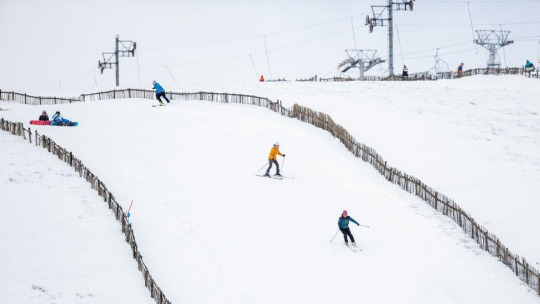
0 notes
Text
Après Ski: How to Make the Most of Your Ski Trip Off the Slopes
Skiing is undoubtedly exhilarating, but it’s not just about conquering the slopes. A ski trip offers more than just a chance to glide down powdery mountainsides—it also presents an opportunity to indulge in the vibrant culture of après ski. Après ski refers to the social activities, entertainment, and relaxation that take place after a day of skiing. In this blog, we will explore some of the…
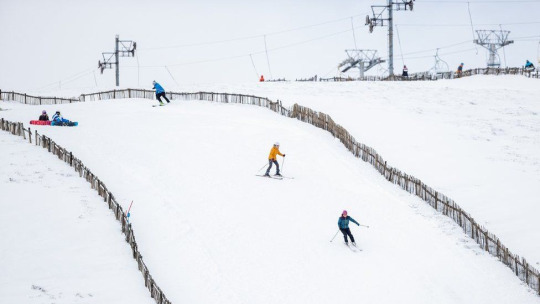
View On WordPress
0 notes
Text
The Ultimate Skiing Gear Guide: What You Need to Know Before Hitting the Slopes
Are you planning a skiing adventure? Whether you’re a seasoned skier or a beginner, having the right gear is essential for a successful and enjoyable experience on the slopes. From skis and boots to clothing and accessories, this ultimate skiing gear guide will provide you with everything you need to know before hitting the slopes. Let’s dive in!
Skis:
Choosing the right skis is crucial for…
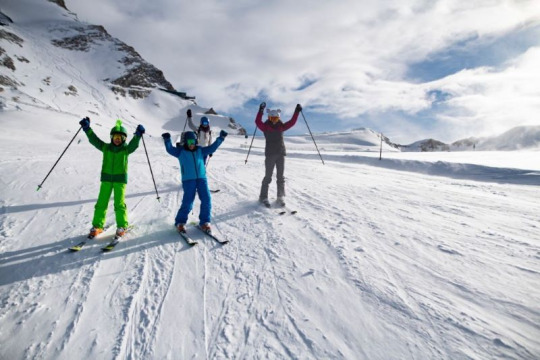
View On WordPress
0 notes
Text
The Ultimate Skiing Gear Guide: What You Need to Know Before Hitting the Slopes
Are you planning a skiing adventure? Whether you're a seasoned skier or a beginner, having the right gear is essential for a successful and enjoyable experience on the slopes. From skis and boots to clothing and accessories, this ultimate skiing gear guide will provide you with everything you need to know before hitting the slopes. Let's dive in!
Skis:
Choosing the right skis is crucial for your skiing performance. Consider your skiing style, skill level, and the type of terrain you'll be tackling. Generally, there are three main types of skis: all-mountain, powder, and carving skis. All-mountain skis are versatile and suitable for a variety of conditions. Powder skis are wider and ideal for deep snow. Carving skis have a narrower waist, allowing for precise turns on groomed slopes. Make sure to select the appropriate length based on your height and ability.
Ski Boots:
Your ski boots are the direct interface between your body and the skis, so finding the right fit is essential. Visit a professional boot fitter to ensure a proper boot fitting experience. They will consider your foot shape, arch, and skiing ability to recommend the perfect boot. Comfort and performance are key factors to consider. A good boot will provide a snug fit, excellent support, and efficient power transfer to the skis.
Ski Bindings:
Bindings are the mechanism that connects your ski boots to the skis. They release during falls to prevent injuries. Make sure the bindings are compatible with your ski boots and that they are adjusted properly by a certified technician. The DIN (Deutsches Institut für Normung) setting determines the release force, which should be adjusted according to your height, weight, skiing ability, and skiing style.
Ski Poles:
Ski poles aid in balance, rhythm, and maneuverability. They should be lightweight, durable, and sized correctly. When standing upright, the top of the pole grip should be at your armpit level. Adjustable poles are recommended, as they allow you to modify the length based on the terrain and skiing technique.
Ski Clothing:
When it comes to skiing clothing, layering is key. Start with a moisture-wicking base layer to keep you dry and insulated. A mid-layer, such as a fleece or softshell jacket, provides warmth, while a waterproof and breathable outer shell protects you from wind, snow, and moisture. Don't forget to wear thermal socks, waterproof gloves, and a helmet for safety. Consider wearing a helmet with built-in ventilation for added comfort.
Goggles and Sunglasses:
Protecting your eyes from the sun, snow glare, and cold winds is crucial. Ski goggles with anti-fog lenses and UV protection are recommended. Look for goggles with interchangeable lenses to adapt to changing light conditions. Additionally, carry a pair of sunglasses for sunny days on the slopes.
Ski Accessories:
Several accessories can enhance your skiing experience. These include:
Helmet camera: Capture your thrilling moments on the slopes.
Ski backpack: Carry essentials like water, snacks, extra clothing layers, and sunscreen.
Hand and toe warmers: Keep your extremities cozy during cold weather.
Neck gaiter or balaclava: Protect your face and neck from wind and frostbite.
Ski wax: Maintain your skis' performance and ensure a smooth glide.
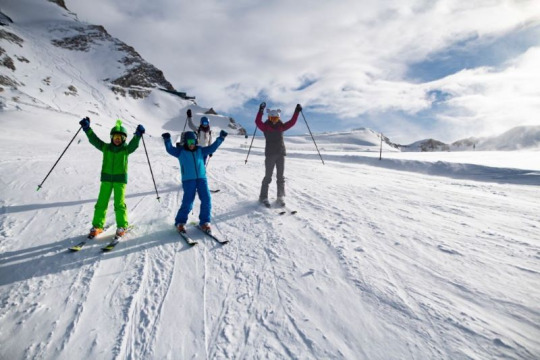
0 notes